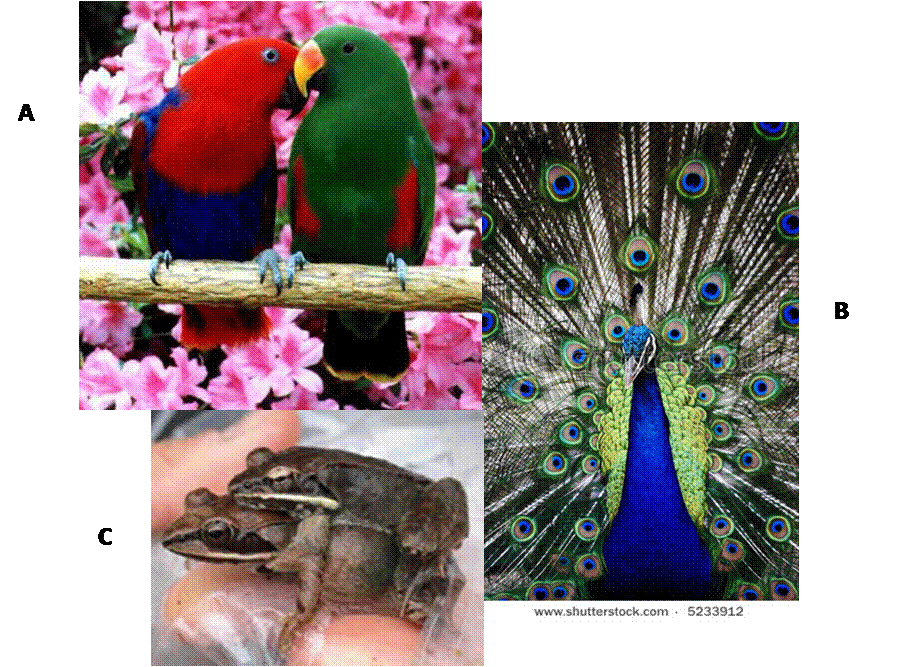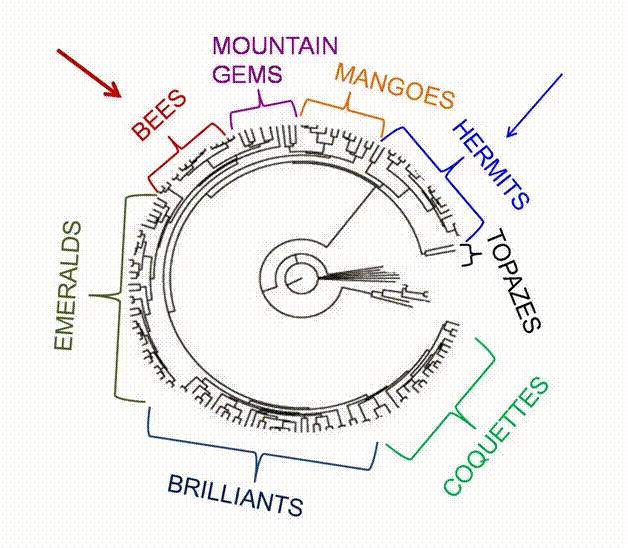Chelsea M. Berns, Ph.D.
Ph.D. in Ecology and Evolutionary Biology
At a microevolutionary level, do 2 sister species of hummingbird that breed in the United States have sexual size and shape dimorphism in their bill morphology? What is the pattern and magnitude of this dimorphism in comparisons to other species?
Berns, C.M. & Adams, D.C. Bill shape and sexual shape dimorphism between two species of temperate hummingbirds: Black-chinned Hummingbirds (Archilochus alexandri) and Ruby-throated Hummingbirds (Archilochus colubris). The Auk 127, 626-635 (2010).
Sexual dimorphism is found throughout the animal kingdom, and its consequences for the ecology and evolution of organisms are often profound, and a number of mechanisms have been proposed to explain its variable distribution among taxa. Darwin (1871) proposed that sexual selection and selection for increased fecundity could be mechanisms that explain patterns of size dimorphism. Other hypotheses suggest that sexual dimorphism evolves from competition over resources between the sexes or because of sex-specific responses to environmental gradients. In some species, sexual dimorphism may be driven by differences in the reproductive roles of males and females (see Fig. 1).

Fig. 1 A) Eclectus parrots, sexually dimorphic coloration. B) Peacock tail, sexually dimorphic ornamentation. C) Woodfrog, sexually dimorphic size.
Hummingbirds present a model system to study sexual dimorphism. They are one example of species that exhibits sexual dimorphism often in plumage, ornamentation, behavior, and body size. Many species also exhibit sexual size and shape dimorphism in their bill morphology, which is tightly linked with feeding efficiency and foraging preferences. Considerable research has examined the functional relationship between hummingbird bills and their food resource niche, which is correlated with differential foraging preferences between species and between the sexes. Several studies have even documented a correlation between sexual dimorphism in bill curvature and foraging behaviors. Thus, bill shape is often implicated as the major cause of trophic differences between hummingbird species, either between species or between the sexes.
Indeed, recent studies of some hummingbird species have shown that males and females have drastic differences in the size and curvature of their bills and that this morphology closely corresponds with the morphology of the flowers that they feed from (see Temeles et al., 2010 and Temeles et al., 2000). With the exception of a species in the "Mangoe" clade (Eulampis jugularis), the majority of work on sexual curvature dimorphism has examined species in the "Hermit" clade (see Fig. 2). All of these species can be considered "neotropical" migrants: those that do not migrate to North America for the breeding season. Two sister taxa of temperate-zone-breeding, migratory species, the Black-chinned Hummingbird (Archilochus alexandri)and the Ruby-throated Hummingbird (A. colubris), present an opportunity to compare bill shape across closely related taxa. The Black-chinned Hummingbird is a generalized and adaptable species whose breeding range overlaps that of several other species of hummingbirds in western North America. The Ruby-throated Hummingbird, on the other hand, is the only species of hummingbird that breeds in eastern North America. Breeding territories of male and female Black-chinned Hummingbirds are found in different habitats, whereas both sexes of the Ruby-throated Hummingbird share the same habitat. Viewing patterns in light of what is known of tropical hummingbirds suggests the hypothesis that bill morphology in these species may be shaped by foraging behavior and that morphological patterns of bill shape may differ between the sexes.

Fig. 2 Phylogeny of hummingbirds adapted from McGuire et al., 2007, highlighting the "Hermit" clade and the understudied "Bee" clade.
From the "Bee" clade, I quantified patterns of microevolution by examining both sexual size and shape dimorphism in the bills of the sister species Archilochus alexandri (Black-chinned Hummingbird) and Archilochus colubris (Ruby-throated Hummingbird). To do so, I collected data using landmark-based geometric morphometrics. Briefly, I took lateral-view images of the bills of 460 museum hummingbird specimens. I then used landmark-based geometric morphometrics to obtain size and shape information. Nonshape variation was removed using a generalized Procrustes analysis that superimposed specimens onto a common coordinate system after accounting for differences in position, orientation, and scale. I then performed statistical analyses to quantify bill morphology both between and within species (see Berns and Adams, 2010 for details).
I found that A. alexandri does not exhibit sexual shape dimorphism, whereas A. colubris does have significant sexual shape dimorphism in its bill morphology. Another finding of our study is that closely related taxa can display differing degrees of sexual shape dimorphism. Why would we expect differences in sexual shape dimorphism among related taxa? One possible explanation is that bill shape is influenced by sexual selection, the strength of which can differ between species. An alternative explanation is that sexual dimorphism may be accentuated in species-poor communities, where members of each sex may inhabit ecological niches occupied by interspecific competitors in species-rich communities (see Fig. 3). Interestingly, the breeding range of A. alexandri overlaps that of several other species of hummingbird in contrast to the breeding range of A. colubris, which does not overlap with any other species of hummingbird. Thus, the lack of potential competitors in the breeding range of A. colubris may allow expansion of its ecological niche that results in morphological differences between the sexes.

Fig. 3 Community structure: A. colubris breeds in a range with no other hummingbird species overlapping, while A. alexandri occupies a breeding range that co-occurs with other hummingbirds. Thus, A. colubris can exhibit sexual shape dimorphism because instead of between-species competition, they can partition niches and have between-sex competition. In contrast, the sympatric hummingbirds have strong enough competition that morphological differences lie not within, but between species
References:
Berns, C.M. & Adams, D.C. Bill shape and sexual shape dimorphism between two species of temperate hummingbirds: Black-chinned Hummingbirds (Archilochus alexandri) and Ruby-throated Hummingbirds (Archilochus colubris). The Auk 127, 626-635 (2010).
McGuire, J.A., Witt, C.C., Altshuler, D. & Remsen, J.V. Phylogenetic systematics and biogeography of hummingbirds: Bayesian and Maximum Likelihood Analyses of partitioned data and selection of an appropriate partitioning strategy. Systematic Biology 56, 837-856 (2007).
Temeles, E.J., Miller, J.S. & Rifkin, J.L. Evolution of sexual dimorphism in bill size and shape of hermit hummingbirds (Phaethornithinae): a role for ecological causation. Philosophical Transactions of the Royal Society B: Biological Sciences 365, 1053-1063 (2010).
Temeles, E.J., Pan, I.L., Brennan, J.L. & Horwitt, J.N. Evidence for ecological causation of sexual dimorphism in a hummingbird. Science 289, 441-443 (2000).